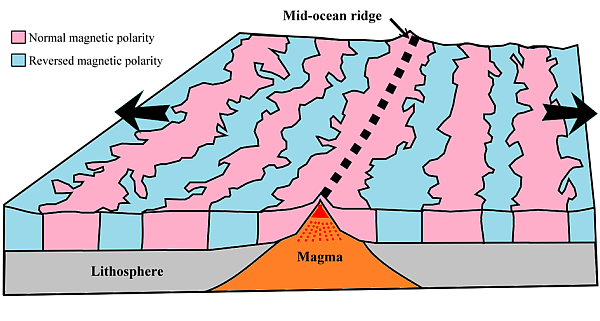Plate Tectonics and Hot Spots
Plate Tectonics and Hot Spots
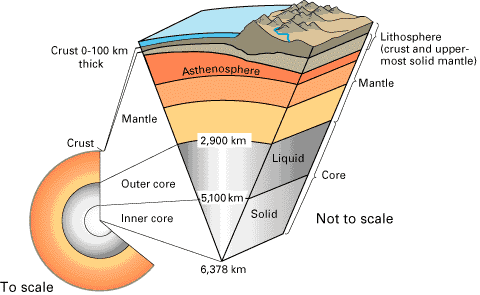
The study of seismic(earthquake waves) are used to identify divisions
within the interior of the Earth into:
- inner core,
- outer core
- "D"
- lower mantle
- transition region
upper mantle
- crust ( continental
and oceanic )
new oceanic crust
Three ways that
plate margins can move relative to one another.
i) Moving away from one
another
ii) Moving towards each other
iii) Sliding past each other
Hot Spots
Magnetic Reversals
see
also E-Learning - Plate Tectonics...
see also
Earthquakes and Seismic Waves...
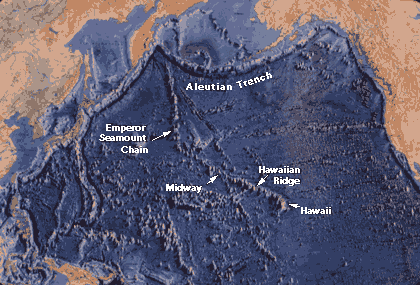

Inner Core
- 1.7% of the Earth's mass;
- depth of 5,150-6,370 kilometers (3,219 - 3,981 miles)
The inner core is solid and unattached to the mantle, suspended in the molten outer core. It is believed to have solidified as a result of pressure-freezing which occurs to most liquids when temperature decreases or pressure increases. The 'core', it is made out of Iron and Nickel. The main thing to remember about the core is that , at around 5500 degrees c, it is very very hot indeed.
Outer Core
- 30.8% of Earth's mass;
- depth of 2,890-5,150 kilometers (1,806 - 3,219 miles)
The outer core is a hot, electrically conducting liquid within which convective motion occurs. This conductive layer combines with Earth's rotation to create a dynamo effect that maintains a system of electrical currents known as the Earth's magnetic field. It is also responsible for the subtle jerking of Earth's rotation. This layer is not as dense as pure molten iron, which indicates the presence of lighter elements. Scientists suspect that about 10% of the layer is composed of sulfur and/or oxygen because these elements are abundant in the cosmos and dissolve readily in molten iron.
"D":
- 3% of Earth's mass;
- depth of 2,700-2,890 kilometers (1,688 - 1,806 miles)
This layer is 200 to 300 kilometers (125 to 188 miles) thick and represents about 4% of the mantle-crust mass. Although it is often identified as part of the lower mantle, seismic discontinuities suggest the D" layer might differ chemically from the lower mantle lying above it. Scientists theorize that the material either dissolved in the core, or was able to sink through the mantle but not into the core because of its density. The 'mantle' and is made of silicate rocks. The heat produced by the core is able to produce convection currents which move the Mantle rocks about in the same way that a gas burner will move the water in a pan as it boils (see fig1). However there is no need to start imagining the mantle as being all runny and liquid. The mantle rocks would appear fairly solid to you or I if we could see them, but they can deform under pressure and flow like an extremely viscous fluid in much the same way that glass, which we assume to be totally solid, will over a century or so start to flow down a window and thicken at the bottom.
Lower mantle:
- 49.2% of Earth's mass;
- depth of 650-2,890 kilometers (406 -1,806 miles)
The lower mantle contains 72.9% of the mantle-crust mass and is probably composed mainly of silicon, magnesium, and oxygen. It probably also contains some iron, calcium, and aluminum. Scientists make these deductions by assuming the Earth has a similar abundance and proportion of cosmic elements as found in the Sun and primitive meteorites.
Transition region:
- 7.5% of Earth's mass;
- depth of 400-650 kilometers (250-406 miles)
The transition region or mesosphere (for middle mantle), sometimes called the fertile layer, contains 11.1% of the mantle-crust mass and is the source of basalticmagmas. It also contains calcium, aluminum, and garnet, which is a complex aluminum-bearing silicate mineral. This layer is dense when cold because of the garnet. It is buoyant when hot because these minerals melt easily to form basalt which can then rise through the upper layers as magma.
Upper mantle:
- 10.3% of Earth's mass;
- depth of 10-400 kilometers (6 - 250 miles)
The upper mantle contains 15.3% of the mantle-crust mass. Fragments have been excavated for our observation by eroded mountain belts and volcanic eruptions. Olivine (Mg,Fe)2SiO4 and pyroxene (Mg,Fe)SiO3 have been the primary minerals found in this way. These and other minerals are refractory and crystalline at high temperatures; therefore, most settle out of rising magma, either forming new crustal material or never leaving the mantle. Part of the upper mantle called the asthenosphere might be partially molten.
The 'crust'
The relatively thin outer layer of the planet which floats on top of the mantle. This is the only section of the planet that humans have ever actually seen and makes up all the continents and all the ocean bed.The rigid, outermost layer of the Earth comprising the crust and upper mantle is called the lithosphere.It is very important to note that there are two totally different types of crust on planet earth.
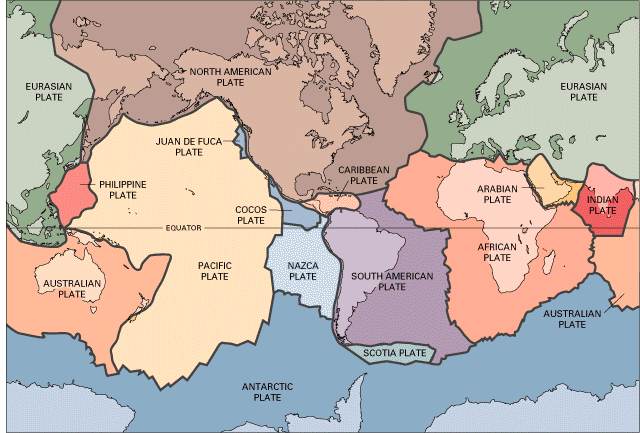
Continental Crust
The first type of crust is called Continental Crust is relatively light and buoyant, made of predominantly granitic rocks, and can be up to 65km thick.Only a few rock typesake up about 99% of the crust . They are :
Igneous rocks in the first row: granite, gabbro, basalt.
Metamorphic rocks in the second row: gneiss, schist, amphibolite.
Sedimentary rocks in the third row: sandstone, shale, limestone
- 0.374% of Earth's mass;
- depth of 0-50 kilometers (0 - 31 miles).
The continental crust is about 150 kilometers (93 miles) thick with a low-density crust and upper-mantle that are permanently buoyant. Continents drift laterally along the convecting system of the mantle away from hot mantle zones toward cooler ones, a process known as continental drift. Most of the continents are now sitting on or moving toward cooler parts of the mantle, with the exception of Africa. Africa was once the core of Pangaea, a supercontinent that eventually broke into todays continents. Several hundred million years prior to the formation of Pangaea, the southern continents - Africa, South America, Australia, Antarctica, and India - were assembled together in what is called Gondwana.
Oceanic crust
The second type called Oceanic crust, by contrast, is relatively dense, made of basaltic rocks and only between 6 and 10km in thickness.- 0.099% of Earth's mass;
- depth of 0-10 kilometers (0 - 6 miles)
It has a thickness of almost 7 kilometers and it is basically made of basaltic rocks. The floor of the oceans is made up of rocks containing mainly silica and magnesium. This is why it is referred to as Sima. Oceanic crust is not only thinner and denser than continental crust, and it is also much younger than it and has a different chemical composition. When magma from the mantle of the earth finds a way up, it comes into contact with water that cools it down quickly. It is forced to take the shape of pillows.
New oceanic crust
Forms through volcanism in the form of fissures at mid-ocean ridges which are cracks that encircle the globe. Heat escapes the interior as this new lithosphere emerges from below. It gradually cools, contracts and moves away from the ridge, traveling across the seafloor to subduction zones in a process called seafloor spreading. In time, older lithosphere will thicken and eventually become more dense than the mantle below, causing it to descend (subduct) back into the Earth at a steep angle, cooling the interior. Subduction is the main method of cooling the mantle below 100 kilometers (62.5 miles). If the lithosphere is young and thus hotter at a subduction zone, it will be forced back into the interior at a lesser angle.Both types of crust float 'like rafts on a swimming pool' (Van Andel) on the mantle. However, the first type, being both more buoyant and thicker, always sits with its upper surface higher than the upper surface of the second type. We therefore are presented with a split level earth with two different heights of crust. Now, when we bring water into the equation we find that the second, lower type of crust is in fact entirely submerged by the waters of the oceans and so is known as 'oceanic crust'. In contrast the second, thicker, crust type usually protrudes above the ocean surface forming continents and is known as 'continental crust'. The few areas where continental crust gets covered by the ocean are known as continental shelves.
Why was it that when many continents are made up of rocks many billions of years old, no rocks of over 200 million years old could be found on the ocean bed? Indeed, most oceanic rocks were less that 100 million years old. It seemed that not only did we have a two level planet, but also a two age planet with young oceans and ancient continents.
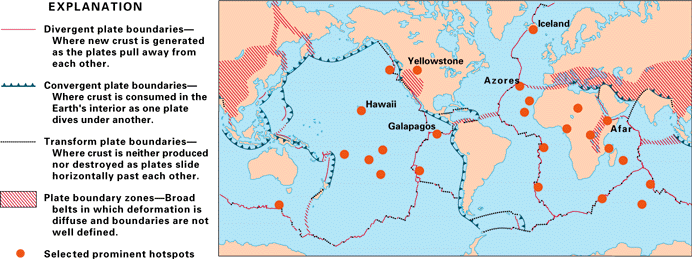
What were the strange ridges found in the middle of the ocean bed? The use of the precision depth recorder to map the sea bed using echo sounding allowed us for the first time to see what the deep ocean floor was like. The vast majority of it turned out to consist of mile after mile of tedious flat plain, perhaps with the occasional volcano. However, right along the centre of each ocean ran a vast ridge. These mid-oceanic ridges encircle the whole planet, straddling it like the seam on a tennis ball. The centre of each ridge was associated with volcanoes, tension-type earthquakes and young rocks.
Fossil evidence of plate movements over time and indicating an original supercontinent

Rock age and deposited sediment depth increased away from the ridge, toward the continents.
Why is it that the bedrock's pattern of magnetic pole reversal formed long stripes, running parallel to the ridge, which were symmetrical on either side of it?
Finally, in 1963 Fred Vine and Drummond Matthews realised what all this meant, and put together one of the most important theories in the history of earth sciences. What they said was this:
"The mid-oceanic ridges are centres of sea floor spreading where new crust is formed as lava wells up to the surface, in-so-doing pushing the crust on either side further apart, thus causing the continents to move."
The ocean floor, is something like a giant conveyor belt. Lava is being extruded all the time forming new crust at the centre of the ridge. On either side of this the crust is being pushed apart by the new material at a rate of 2 to 20 cm per year. This mechanism has meant that the whole sea bed is slowly being pushed along. At the edge of an oceanic crust plate where it meets a continent, the continent can also get pushed along by this process producing continental drift. The ultimate driving force for this mechanism is not yet fully understood, but is thought to involve the convection currents set up within the mantle by the heat of the core.
This is why Australia and India have been moving further apart since the break up of Gondwana . They are being slowly pushed apart by new crust erupting in the mid ocean ridge, and we can actually measure this happening these days using the satellite based global positioning system.
At the edges of the plates, where they rub against each other, earthquakes occur due to the friction.
Three ways that plate margins can move relative to one another.
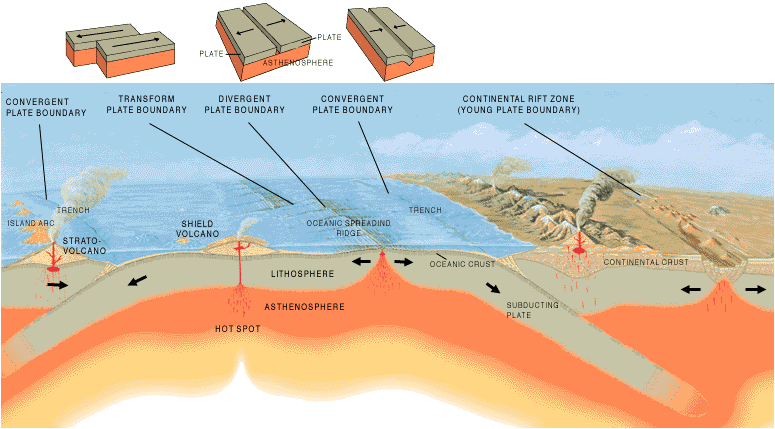
i) Moving away from one another.
Two Ocean Plates Diverging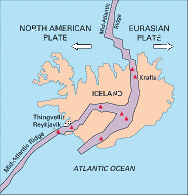
This results in new oceanic crust being formed as lava fills the gap between the plates. This is known as a constructive margin and is what occurs at a mid oceanic ridge.
new crust and unique life near "black smoker" on mid-ocean ridge

Two Continental Plates Diverging
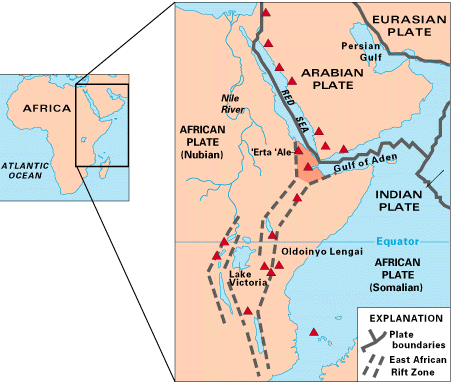
This results in a block between the plates dropping down and forming a "rift valley".
These rifts go deep into the crust bring metallic minerals like chromium and platinum near the surface
ii) Moving towards each other
Continent / Continent Convergence
Ocean / Continent Convergence
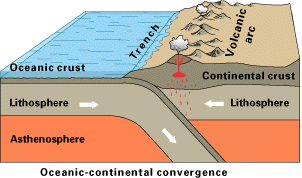
Ocean / Ocean Convergence
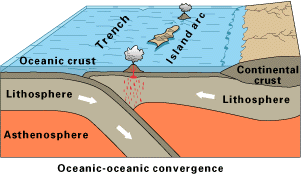
These margins are called "destructive margins" since crust gets destroyed as the plates collide.
If two continental plates collide then the crust ruptures and crumples up forming a mountain range such as the Himalayas (which are forming as the Indian plate slowly crashes into the Eurasian plate.)
Himalayas
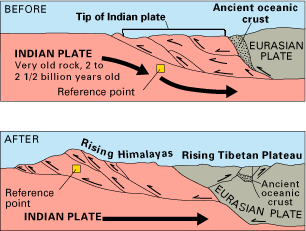
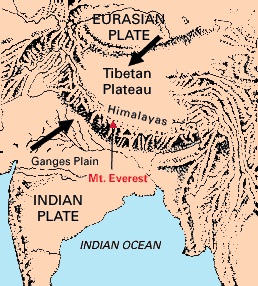
Alternatively if an oceanic plate collides with a continental plate then the continental crust, being more buoyant, rides over the top of the oceanic plate. The oceanic plate is subducted back into the mantle, thus destroying oceanic crust, to balance the crust being produced at the mid oceanic ridges.
This is why all oceanic crust is much younger than the continental crust; it is constantly being recycled. Even though new oceanic crust is always being formed, old crust is always being destroyed, and so there is no very ancient oceanic rock around. If this didn't happen, the world would have to be constanly expanding to make way for the extra crust being formed!
As the oceanic plate gets pushed down into the mantle, a vast ocean trench is formed by the drastic lowering of the sea bed. These trenches are by far the deepest areas of the worlds' ocean and are home to some of the planet's most extraordinary wildlife. Sometimes some of the subducted oceanic plate, once melted into magma within the mantle, begins to rise and push up through the continental plate on the other side, forming volcanoes, and ultimately, a mountain range such as the Andes (caused by the Nazca plate sinking below the South American plate).
iii) Sliding past each other
Tectonic plates are also able to slide in opposite directions whilst lying
next to one another. As crustal material is neither destroyed nor created
in this procedure these are known as conservative margins. However the
edges of the plates are rough and cause friction. This means that rather
than sliding smoothly past each other they tend to jam and stick in one
place until the pressure builds up to be so great that it has to give. At
that point the plates move suddenly, causing an earthquake. For this
reason the fault lines along conservative plate margins tend to often be
the most dangerous earthquake zones in the world.Sliding Past

Hot Spots
Hot spot are caused when a plume of mantle magma convects to the surface.Mantle hot spot creating the island arc of Hawaii
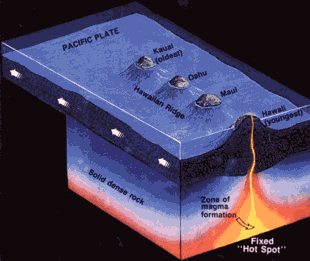
Hot Spot remains in one place as Australian continent drifts northward
This results in a series of volcanoes and lava flows along the eastern seaboard.Oldest activity in the north and getting younger as you move southwards.At present the hot spot has faded and there is no current volcanic activity.
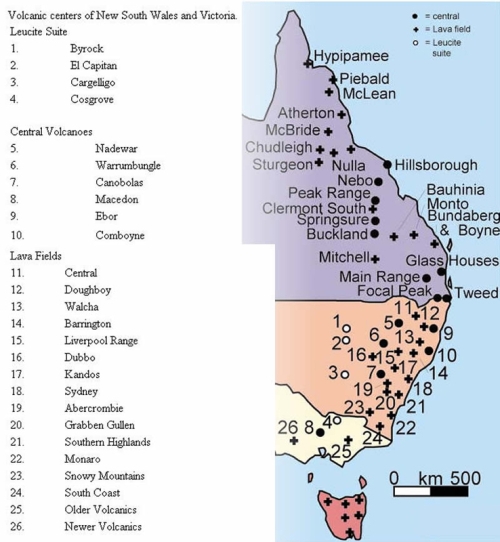
Magnetic Reversals - How we know new crust is being formed along mid-ocean ridges
The earth periodically undergoes a reversal in the polarity of its magnetic field.North becomes South...South becomes North and so on
So as new crust is formed mid-ocean on both sides of the rift at the same time... you end up with matching parallel bands of similar magnetic polarities.
